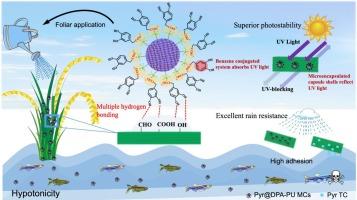天然酚酸功能化聚氨酯微胶囊,具有优良的叶面保持性和紫外线防护,提高农药的有效性和安全性
IF 13.2
1区 工程技术
Q1 ENGINEERING, CHEMICAL
引用次数: 0
摘要
农药的叶片附着性及其光稳定性是现代精准农业面临的关键挑战,直接影响到农药的药效、生物利用率和环境安全性。在此,我们利用天然酚酸 3,4-二羟基苯乙酸(DPA)制备了吡唑醚菌酯负载型聚氨酯微胶囊(Pyr@DPA-PU MCs),该微胶囊具有较高的包封效率(95.57 %)和负载能力(75.33 %)、良好的铺展性和叶片附着性以及优异的光稳定性。结果表明,DPA接枝聚氨酯外壳通过儿茶酚基团与水稻叶片上的官能团之间的多重氢键作用,可显著增强聚氨酯 MCs 与水稻叶片之间的相互作用。此外,酚酸的疏水性、刚性和共轭结构赋予了聚氨酯 MCs 特殊的紫外线防护能力,其性能优于商业配方 Seltima。体外生物活性测试表明,Pyr@DPA-PU MCs 对根瘤菌(Rhizoctonia solani)具有卓越的抑制作用。同时,体内生物活性测试表明,Pyr@DPA-PU MCs 明显改善了 Pyr 的光稳定性,在紫外线照射 72 小时后仍能保持 48.46% 的抗真菌活性,而 Seltima 为 43.91%,Pyr 溶液仅为 17.71%。值得注意的是,与 Pyr TC 相比,Pyr@DPA-PU MCs 对斑马鱼和 LO2 细胞的毒性更低。本研究提出了一种通过天然酚酸来提高聚氨酯 MC 性能的新方法,从而通过增强叶片附着力和光稳定性来提高杀虫剂的功效,最终促进更可持续的杀虫剂管理实践。本文章由计算机程序翻译,如有差异,请以英文原文为准。

Natural phenolic Acid-Functionalized polyurethane microcapsules with superior foliar retention and UV protection for improving pesticide efficacy and safety
The leaf adhesion of pesticides and their photostability are critical challenges for modern precision agriculture, directly affecting efficacy, bioavailability, and environmental safety of pesticides. Herein, we utilized the natural phenolic acid 3,4-dihydroxyphenylacetic acid (DPA), known for its exceptional antioxidative, adhesive and UV-resistant properties, to prepare pyraclostrobin-loaded polyurethane microcapsules (Pyr@DPA-PU MCs), which achieved high encapsulation efficiency (95.57 %) and loading capacity (75.33 %), excellent spreading and leaf adhesion, as well as superior photostability. The results indicated that DPA-grafted PU shell can significantly enhance the interaction between PU MCs and rice leaves by multiple hydrogen bonds between the catechol groups and the functional groups on rice leaves. Furthermore, the hydrophobic, rigid, conjugated structure of the phenolic acids endows the MCs with exceptional UV protection for Pyr technical concentrate (TC), outperforming to the commercial formulation Seltima. In vitro bioactivity test showed that Pyr@DPA-PU MCs exhibits superior inhibitory effects against Rhizoctonia solani. Meanwhile, in vivo bioactivity tests indicated that Pyr@DPA-PU MCs markedly improved the photostability of Pyr, retaining 48.46 % antifungal activity against Rhizoctonia solani after 72 h of UV exposure, compared to 43.91 % for Seltima and only 17.71 % for a Pyr solution. Notably, Pyr@DPA-PU MCs exhibited reduced toxicity to zebrafish and LO2 cells relative to Pyr TC. This study presents a novel approach to enhance the performance of PU MCs through natural phenolic acid, thereby improving pesticide efficacy via enhanced leaf adhesion and photostability, ultimately contributing to more sustainable pesticide management practices.
求助全文
通过发布文献求助,成功后即可免费获取论文全文。
去求助
来源期刊

Chemical Engineering Journal
工程技术-工程:化工
CiteScore
21.70
自引率
9.30%
发文量
6781
审稿时长
2.4 months
期刊介绍:
The Chemical Engineering Journal is an international research journal that invites contributions of original and novel fundamental research. It aims to provide an international platform for presenting original fundamental research, interpretative reviews, and discussions on new developments in chemical engineering. The journal welcomes papers that describe novel theory and its practical application, as well as those that demonstrate the transfer of techniques from other disciplines. It also welcomes reports on carefully conducted experimental work that is soundly interpreted. The main focus of the journal is on original and rigorous research results that have broad significance. The Catalysis section within the Chemical Engineering Journal focuses specifically on Experimental and Theoretical studies in the fields of heterogeneous catalysis, molecular catalysis, and biocatalysis. These studies have industrial impact on various sectors such as chemicals, energy, materials, foods, healthcare, and environmental protection.
 求助内容:
求助内容: 应助结果提醒方式:
应助结果提醒方式:


